Article
SensusQ analysis on the Shahed-131/136/238 one-way attack UAVs
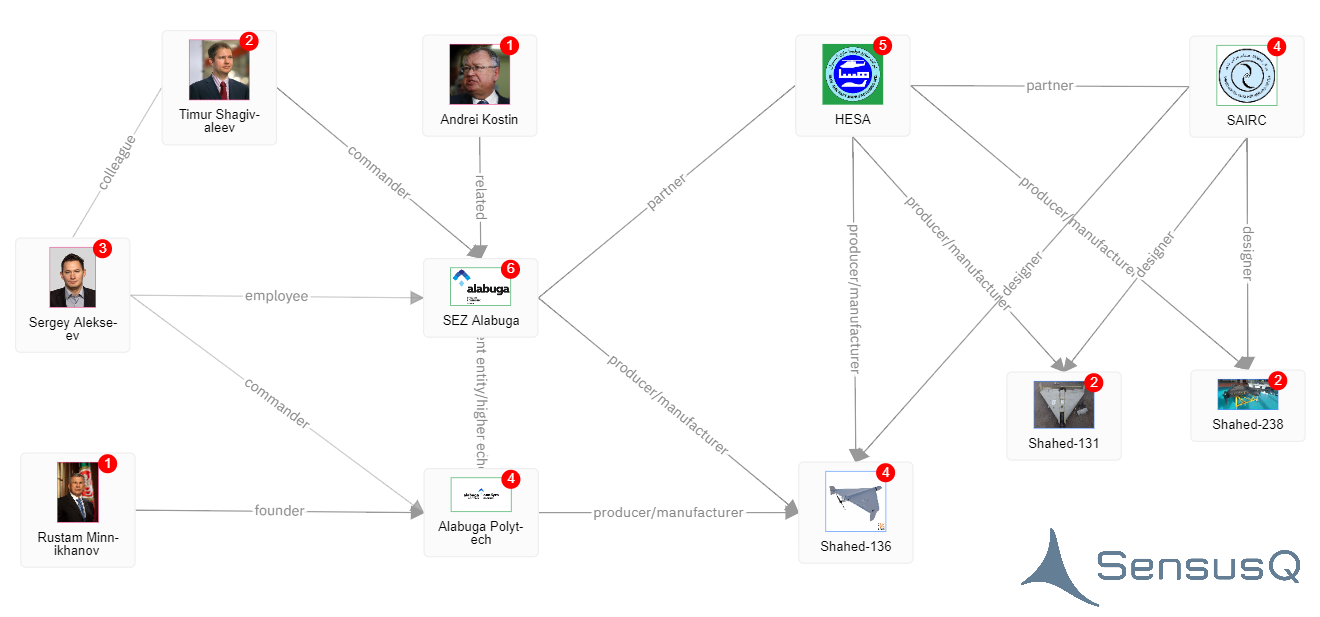
Introduction
Previously, we’ve discussed the Orlan-10, the so-called Cartographer and ZALA Aero Group's 421-16E, 421-16E2, and 421-16EM reconnaissance UAVs as well as the Lastochka and ZALA Lancet loitering munitions. In this article, we take an in-depth look at the analysis of the HESA Shahed-136, Shahed-131 and Shahed-238 OWA UAVs, which provides insight into the development of military technologies used by Russia.
At an Iranian defence exhibition in 2015, Iran unveiled its Shahed-131. [1] [Figure 1] In September 2019, two major Saudi oil facilities—Abqaiq and Khurais—were severely damaged by swarms of UAVs, allegedly launched by Houthi rebels in retaliation for the Kingdom’s intervention in the Yemen civil war. A few days later, the wreckage of an attacking UAV was displayed at a press conference. The debris included a delta-wing UAV powered by a small rotary engine (called a Wankel engine) driving a wooden propeller. [2] Iranian Shahed UAVs were then detected outside Iran on December 25, 2020, when imagery revealed them in the northern Yemeni province of Al-Jawf, in an area controlled by Ansar Allah, or the Houthis, a Shiite Zaidi rebel movement. [3]
In July 2022, U.S. National Security Adviser Jake Sullivan said that Russia had asked Iran to provide it with “hundreds” of UAVs, including weaponised drones, for use in the ongoing war in Ukraine. At the time, it was unclear whether Iran had provided Russia with any UAVs, but according to the U.S. information, Iran was already preparing to train Russian troops on their use. [4]

Shahed-136 entered Russian service in Ukraine under the name Geran-2 no later than September 2022. [5] On September 13, 2022, the initial use of the Shahed-136 was evidenced by photographs of the remains of a UAV with the inscription in Russian: Герань-2, lit. 'Geranium'-2, operated by Russian troops. The Shahed-136 UAV had been shot down by Ukrainian forces and hadn’t detonated on impact as designed. [6] [7] [Figure 2]
When asked whether Russia had used Iranian drones in its campaign in Ukraine, Kremlin spokesman Dmitry Peskov said he had no information about their use. "Russian equipment with Russian nomenclature is being used," he said. "All further questions should be addressed to the Ministry of Defense." [8]
Be that as it may, on 20 October, Russian military expert Ruslan Pukhov, director of the Moscow-based Centre for Analysis of Strategies and Technologies, was caught on the hot microphone during a TV interview, saying that Russia had obtained UAVs from Iran. “We won’t rock the boat, so I beg you not to focus too much on the Iranian […] because we all know that they’re Iranian, but the authorities haven’t admitted it," he said, apparently unaware that his interview with Russian business channel RBC-TV had already gone live. [9] However, Pukhov himself later said that perhaps this did not happen at all. "I don't remember saying that.... Maybe I did say it, maybe I didn't. I don't remember, unfortunately... My brain is bad after Covid. [10]

Iran has also denied claims that it has sent the UAVs for use in Ukraine, stating that it is neutral in the war. [11] However, on 2 September 2022, Islamic Revolutionary Guard Corps (IRGC) commander General Hossein Salami stated at an arms exhibition in Tehran that "some major world powers" had acquired Iranian military equipment and the IRGC was "training them in the use of this equipment," which may refer to Russia. [12] On 5 November 2022, the Iranian government admitted sending a limited number of UAVs to Russia, but months before the start of the Russian invasion of Ukraine. [13]
Be that as it may, Russian forces continue to conduct indiscriminate strikes on Ukrainian territory, using a variety of missiles and Iranian attack drones. Russia is deliberately striking civilian infrastructure and non-military targets to harm civilians and attempt to sow terror among the Ukrainian population. [14] Noisy UAVs traverse hundreds of kilometres before striking civilian energy infrastructure across Ukraine. Iran's HESA-manufactured Shahed-136 kamikaze UAVs can hardly be called state-of-the-art compared to the expensive hypersonic weapons being developed by Russia and the US, but Russia has launched thousands of these UAVs and there is no sign that this will end. [15]
1. There are two companies involved in the production of Shahed UAVs in Iran.
The main manufacturer of the Shahed UAV is Iran Aircraft Manufacturing Industries (HESA), an Iranian company specializing in the production of military and civil aircraft and UAVs; a subsidiary of the Iran Aviation Industries Organization, a state-owned enterprise under the Iranian Ministry of Defense and Armed Forces Logistics. [16] HESA Aircraft Industries, headquartered in Tehran, was founded in Iran during the previous imperial regime as a Bell Textron factory for the licensed production of Bell helicopters. After the revolution it was nationalised and merged into the government-owned Iran Aviation Industries Organisation. Today, HESA provides maintenance services for some of Shah-era the US-origin aircraft that are still in service. [2] The company also manufactures or maintains military and passenger helicopters, fixed-wing aircraft, and UAVs. In the early 2000s, Antonov together with HESA began production of An-140 cargo and passenger aircraft in Iran. [17] According to the US Department of the Treasury, HESA has manufactured variants of the Ababil series of UAVs used by the IRGC. According to a UN Panel of Experts, it likely produces the Qasef-1 UAV used by Houthi rebels in Yemen, and has also reportedly developed and manufactures numerous other UAVs. [16]
There is another company that is closely associated with the Shahed UAVs - The Shahed Aviation Industries Research Centre (SAIRC), part of Shahed Aviation Industries, located near Isfahan. While HESA also has its own design bureau specializing in UAVs, SAIRC, which also functions as a design bureau, is handing over its designs to HESA for mass production - an arrangement that appears to have caused some unspecified friction between the two organizations. [2]
HESA is listed and sanctioned by the European Union as early as 26 July 2010 as an organisation linked to Iran's development of nuclear weapon delivery systems. It is also subject to sanctions by the governments of the United States, Australia, Canada, and South Korea, restricting business and financial transactions with it and freezing its assets in those countries. [16] Also in November 2022, SAIRC was sanctioned by U.S. Department of the Treasury’s Office of Foreign Assets Control (OFAC) as "a firm engaged in the production of Iranian UAVs, which Russia has used in devastating attacks against civilian infrastructure in Ukraine". [18]
2. Shahed's production in Russia at Alabuga Polytech
In early June 2023, US National Security Council official John Kirby said that Russia, with the help of Iran, was building an attack drone factory that should be fully operational by early 2024. Iran supplied materials that Russia used to build its own UAV factory in the Alabuga Special Economic Zone (SEZ). [19] But just a month later, in July 2023, the publication “Protocol” and the YouTube channel “Razvorot @RZVRT” published an investigation, in which they talked about the assembly of Iranian-origin combat drones in the SEZ “Alabuga”. [20]
To understand why Alabuga (also spelled Elabuga, Yelabuga; Russian: Елабуга; Tatar: Алабуга) became a place where Shaheds are being assembled and manufactured, we must know the history of Alabuga. 25 years ago, in 1998, at the level of the Republic of Tatarstan in Russia, where Alabuga is located, the law "On Free Economic Zone "Alabuga" was adopted. Later it was abolished and a full-fledged SEZ was created there only in 2006. [20] All conditions were created there to attract investors from all over the country and abroad: highways, railways, access to inland waterways, an airport, its own thermal power station, a hotel complex, modern cottage complex for permanent residents, an International school etc. Companies in «Alabuga» were exempt from paying taxes on property, land and transport, the income tax was only 2%. In 2018, SEZ «Alabuga» became the best SEZ in Europe for «New investments» according to fDi Intelligence for the third time. [21]

The problem of a shortage of professional personnel began to arise, as residents needed more qualified workers. To solve this problem, the Head of Tatarstan Rustam Minnikhanov personally opened the Alabuga Polytech educational centre in 2021. Instead of entrance exams, students played games in a special app, and instead of dormitories, they lived in studios for two. According to the advertisement, it was planned to train new "Elon Musks" there. [20]
So, everything went uphill there until the full-scale invasion of Ukraine by the Russian army began on 24 February 2022. With the outbreak of the war, economic sanctions against Russia followed, and most of the foreign companies left the country. As the war dealt a painful blow to Alabuga's budget, the mobilization took a toll on its human resources. All enterprises, including Alabuga's subsidiaries, were ordered to hire men for the front line. In order to maintain its own staff, Alabuga's HR department began recruiting volunteers from outside: men were formally enrolled in the staff as junior personnel, and then their data were passed to the military enlistment offices. But this method quickly ran out of steam. Therefore, the management of Alabuga decided to accept a defence order so that the employees would receive a state deferment from mobilisation. [20]
Negotiations for the production of Orlan-10 UAVs failed, and the body armour project never became a business, but the Shahed UAV project was eventually launched, despite the fact that there were initially problems with the financing of the Russian-Iranian deal. After the initial agreement on the purchase of the "franchise" was reached and the amount was agreed, it turned out that Iran did not need rubles. At first, they demanded payment in gold. The Russian side found the necessary amount of precious metal and, according to the source, a whole plane with gold was being prepared for shipment. At the last moment, Iran changed its mind and wanted payment in dollars. Everything came to a halt: the Iranians wanted payment in cash, but Russia simply did not have that many dollars. [20] Eventually, Russia still paid for the deal in literal gold and sent just over 2 tonnes of bullion to Iran. [22]
The plant in Tatarstan is expected to produce at least six thousand UAVs per year. Initially, the Shahed-136 OWA UAVs were only assembled in Alabuga and their components were entirely supplied from Iran. Iran also implied training of specialists from Alabuga at the Iranian production facility. Gradually, imports of components from Iran were to be reduced. First, the UAV body was excluded from the list of imported goods, since it was easy to manufacture, then the GPS module and processor, since the Iranian UAVs had them quite primitive and available in the AliExpress online store. Following electronics, Alabuga planned to learn how to make engines. [23]
For security reasons, several interesting measures have been implemented at Alabuga. For example, in one of the presentations containing information and images of Shaheds, UAVs were called “boats” and Iran was referred to as Belarus.[24]
According to the investigators, the hangar where the UAVs are assembled occupies 40,000 square meters (about six football fields). During 2024, the management of Alabuga plans to move the production of some components to the territory of the economic zone, as well as automate it. The total area of hangars will be more than 100,000 square meters. [23] Plans for the Shahed drone assembly plant were leaked in the Telegram channel "ВЧК-ОГПУ". [25] [Figure 4].

In August 2023, The Washington Post obtained some leaked documents [26] that were analysed by the Institute for Science and International Security. [27] According to the analysis, the entire Shahed project in Alabuga faced delays in its early stage. Iran was unable to provide airframe designs at Alabuga's request, which appears to have delayed the planned UAV assembly, originally scheduled for April 2023, by at least one month. Additional delays in establishing the necessary production capabilities may have already lead to disruptions in production and deliveries to the military. So, the initial plans for Alabuga in the fall of 2022 have not been realized. More recent documents show that the timeframe had been amended as well; instead of delivering 6,000 Shahed UAVs by January 2025, they will be ready later, by September 2025. [27]
Alabuga also appears to have been heavily dependent on Iran for the supply of key components, other than the hull and raw materials for the airframe as well as a few components manufactured in Russia. As for the more than 130 electronic components, Inertial Navigation Systems (INS), accelerometers, GPS, Field Programmable Gate Arrays (FPGA), connectors and other subcomponents listed in the documents as being required for the Shahed-136 UAV, one of the documents identified only four as being made in Russia. The rest were manufactured predominately by U.S. firms, but also by French/American, Japanese, Swiss, Taiwanese, Chinese, Dutch, and other suppliers. More than 80 percent of the electronic components, not counting connectors, were manufactured by U.S. companies, and most of them were electronic integrated circuits made in only a few countries, but not in Russia. If that is the case, Alabuga may have to rely on additional imports of major components from Iran to compensate for delays in domestic production of critical components including engines, navigation systems, and warheads. Further delays could be caused by procurement shortfalls, staff shortages, or problems in reverse engineering Iranian manufacturing processes. Combined, this indicates a discrepancy between Alabuga’s ambitions and real capabilities. [27]
In Alabuga, Shahed-136 OWA UAVs are assembled by students of the Alabuga Polytech College, who earn up to 70,000 rubles a month. Students report harsh working conditions, high levels of supervision and intimidation from management. They are forbidden to disclose information about the project and face a fine of up to two million rubles and deportation. Students face physical and psychological challenges. [25] The forced assembly of UAVs is based on the fact that teenagers are encouraged to enrol in a "dual program" - that is, from the first year, they can study and work at the same time. [28] Upon enrolling in college, the student's parents sign a document obliging them to pay a large sum of money in case of expulsion. [29] Also, Alabuga's student training contract stipulates a ban on the disclosure of information about production. In case of violation of the ban, the student is obliged to pay 1.5–2 million rubles to the college. When parents realise what lies behind this “contract,” it is no longer possible to get their children out of this system without paying a huge sum. So, behind the beautiful words about the upbringing of "Elon Musks" there is, in fact, teenage slavery. However, the pay for assembling UAVs is good, and therefore most students do not mind the harsh conditions. [28]
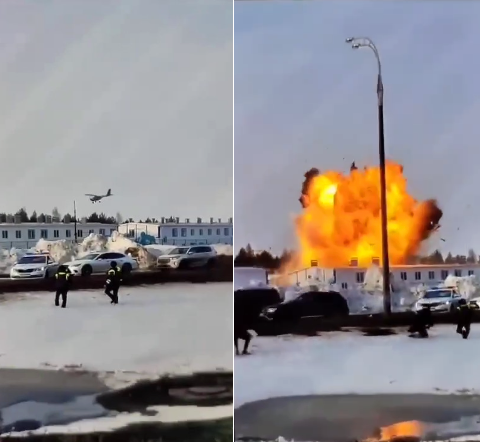
In the early morning hours of 2 April 2024, the Main Intelligence Directorate of the Ministry of Defense of Ukraine (GUR) conducted an UAV attack on the Shahed OWA UAV assembly plant in Alabuga. [31] [Figure 5] According to the authorities the Republic of Tatarstan, facilities in Alabuga were attacked by UAVs, but there was no serious damage, and the technological processes of the enterprises were not disrupted. [32] In any case, at least 13 people were injured as the result of one of the UAVs hitting the workers' dormitory. According to the Ministry of Health of Tatarstan, all the victims were students of the Alabuga Polytech College, and six of the wounded remained in hospital. [33]
Based on the published data, SensusQ cannot assess how severe the damage to the assembly plant is or whether the plant will be able to continue assembling the Shahed-136 OWA UAVs or not. But students of the Alabuga Polytec have witnessed the damage that can be caused by such UAVs, which they themselves assemble at the factory. They have also likely realised that by assembling UAVs to attack Ukraine, they themselves have become targets of Ukrainian attacks. Unfortunately, they cannot refuse to work at the factory, as they are bound by a contract. Also, the factory management is likely to promise the students that the attack was an unfortunate exception and will not happen again. Thus, the April 2 attack is unlikely to cause a major setback to the Alabuga UAV factory in terms of personnel. But circumstances could change if attacks on the plant are repeated.
The April 2 strikes were the first Ukrainian attacks on Alabuga. The distance to the target, which is more than 1,000 kilometres from the Ukrainian border, represents a significant change in Ukraine’s demonstrated ability to launch long-range strikes far to the rear of Russia. Such Ukrainian strikes are necessary to degrade Russians' ability to carry out terrorist strikes with OWA UAVs against Ukrainian infrastructure deep in the country's rear. SensusQ estimates that the April 2 strike will not remain Ukraine's only attempt to destroy the Shaheds UAV factory in Alabuga.
3. The cost of Shahed UAVs
The exact cost of most Iranian UAVs is unknown. The Shahed-136 kamikaze UAVs could be very cheap to produce as they are close to Chinese commercial drones. Many experts have estimated that the price of the Shahed-136 UAV could be ~20–50 thousand dollars. [2] [33] [34] [35] Thus, the Shahed may cost only a fraction of the cost of a full-size missile. For example, Russia's Kalibr cruise missiles, which has been widely used in Ukraine, cost the Russian military approximately $1 million each. [33] The 2,200 kg KH-101, a mainstay of Russia's strategic campaign against Ukraine, is reputed to cost around $13 million. The Shahed's warhead is about one-tenth the size of cruise missiles, but has sufficient range for theatre operations, is precise and might be much cheaper than cruise and ballistic missiles. [2] Furthermore, it is not cheap to shoot down a Shahed with an air defence missile, as such missiles can cost between $140,000 and $500,000. [36]
However, destroying Shaheds is not always so costly, since the German Gepard self-propelled anti-aircraft artillery system (SPAAG) has proven to be very effective and cheap against Shahed-136/131 OWA UAVs. [37] Any machine gun can also take a Shahed down if it is within range. Unfortunately Gepards and other machine guns are not always where the Shaheds fly, especially since the Russians often change routes to find gaps in Ukrainian air defence.
In early February 2024, a hacker group called the Prana Network hacked into the email servers of the IRGC and obtained data on the sale of Shahed OWA UAVs to Russia. The documents show that a single Shahed-136 would have cost Russia $375,000, but Russia and Iran negotiated on a lower price per unit for bulk purchase. Thus, the agreement conveyed in the documents shows a price of $193,000 for a Shahed-136 for the purchase of 6,000 units, $1,400,000 for a Shahed-238 for the purchase of 677 units and $900,000 for a guided Shahed-238 with an Electro Optic System (EOS) for the purchase of 2,310 units. [38] [39]
Interestingly, a Russian milblogger justified the "inflated" prices of Iranian UAVs and said that the price of a product for export is determined not only by the cost of its production, but also by many other factors, such as the urgent need to obtain Shaheds, while there is simply no alternative to purchasing from another supplier and with serious political risks that Iran had to take on in the deal, as it publicly denied supplying Shaheds to Russia. [40]
Sanctions are likely to continue to undermine key resources for the Russian defence industry. Russia's isolation limits the number of countries with which it can trade directly, which is likely to increasing the time and cost of acquiring goods it was once able to buy freely. Research by the Bank of Finland Institute for Emerging Economies shows that third countries charge higher price premiums for the exports of some sanctioned goods to Russia. For example, the median growth rate of Chinese exports to Russia across product lines was 186% in value terms, and Turkish exports to Russia were even 665% in value terms. [41]
Thus, the cost information that Prana Network claims to have obtained is likely accurate and it reveals that Shaheds are not as cheap as previously thought. Moreover, if we take into account the Shahed's lower destructive power and the possibility of being destroyed by cheap German Gepard ammunition or even a machine gun, this significantly reduces the financial benefit of Shahed's compared to traditional cruise and ballistic missiles. As you can see, the more advanced Shahed-238 already costs the same as Kalibr missile, and Russia may be forced to use the Shahed UAVs at any cost simply because it does not have enough other means to attack Ukrainian targets deep in the rear.
4. Descriptions and specifications of Shaheds.
4.1 Shahed-131 and Shahed-136
Shahed-131 is an earlier version of Shahed-136, but their principle of operation is similar. [42] They are also visually similar, but the Shahed-131 is slightly smaller and its wingtip stabilisers extend only upwards, while on the Shahed-136 they extend both up and down. [43] A Ukrainian study conducted in 2022 revealed, that the Shahed-131 is made of carbon fibre reinforced with internal metal supports. [42] According to some sources, the original Shahed-131 was powered by a 38 HP Serat 1 rotary Wankel engine. [2] But according to Ukrainian investigators, the Shahed-161 is equipped with an internal combustion piston engine that drives a platform with a fixed-pitch wooden propeller. It is estimated that it can be launched from static rails or from a truck. The UAV payload consisted of a high-explosive (HE) warhead [Figure 6], a copper cone charge and a pre-formed fragmentation case. The explosive content was estimated to be at 10-15 kg of cast explosives.[44]
Analysis of the electronic components showed that they are all civilian, and of the guidance systems, only a civilian-class GPS receiver is used, which allows this UAV to be used exclusively against stationary objects. A system has also been added to GPS guidance that prevents from spoofing GPS signals, but, judging by the description, does not prevent interference. The UAV is also equipped with a primitive inertial system that allows it to maintain an approximate course and altitude in the absence of satellite navigation. That is, when the UAV flies into an area where GPS signals are suppressed, the UAV begins to drift with the wind, and it also encounters errors in the inertial system itself. Depending on wind speed and direction, the deviation may be 5% of the distance covered without GPS. On a 5 km stretch, this would give an error of 250 meters. Obviously, when the GPS signal is received again, the UAV will adjust its flight. [43]
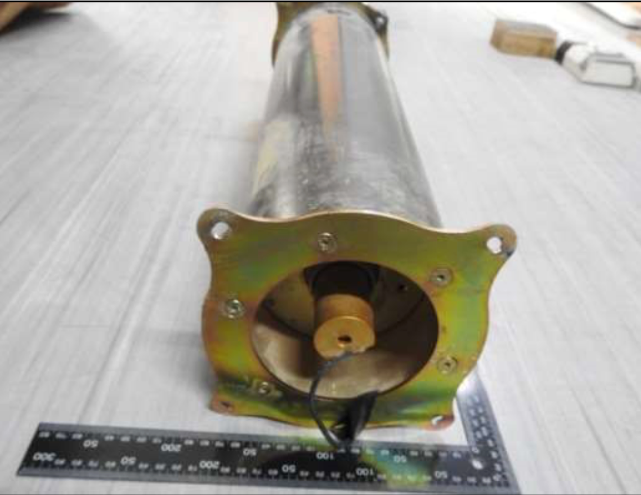
The Shahed 136 is much the same as the Shahed-131, except that it is slightly larger, its warhead is larger and it is fitted with a more powerful 50 HP two-stroke four-piston engine, reverse-engineered from the German-developed Limbach L 550 engine, which is used by aircraft modelmakers around the world, as well as in civilian and military UAVs. [2]
In July 2023, Ukraine's "Defense Express" stated that Russia was already using its own version of Shaheds, which is somewhat different from the Iranian version. Firstly, the serial numbers of Iranian Shaheds begin with the letter "M", whereas in Alabuga they make the beginning of Shaheds with the letter “K”. The body of the Russian Shahed consists of interconnected elements, whereas the Iranian Shahed is solid. The material used in the body of the old Shaheds is similar to printed honeycombs, whereas in the new Shahed it is like polystyrene foam. [Figure 7] The Russian Shahed has also received a new warhead, which is labelled in Cyrillic instead of Latin. The Shaheds' battery has also changed - previously it was made of Li-Ion 18650 batteries, while the Russian UAV is equipped with a gel battery of the Russian brand "Delta Battery". Finally, Russian Shaheds are equipped with antennas with a "Kometa" unit, which provides anti-jamming protection and was not used on the Iranian Shaheds. [45] Later in September, it was reported that Russians had begun packing warheads with tungsten ball shrapnel. [46]
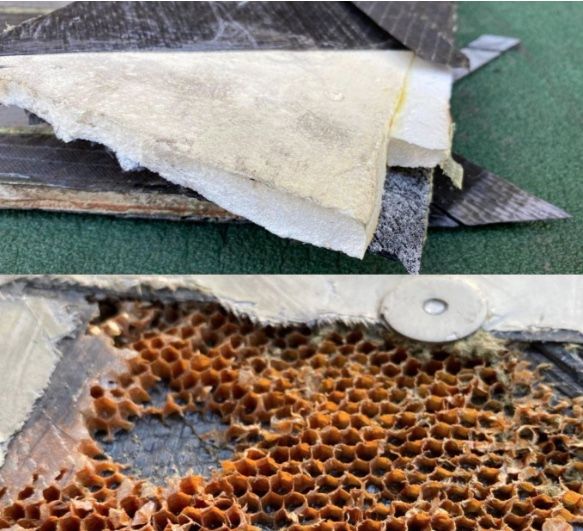
On 25 November 2023, Ukrainian Air Force Spokesman Colonel Yuriy Ihnat said that Russian troops attacked Kyiv with a new modification of Shahed UAVs and noted that these drones are black in colour and contain composite materials that absorb radar signals, making them difficult to detect. [47]
Russia and Iran are constantly experimenting with new technical solutions to improve the performance of Shaheds. On the other hand, due to economic sanctions, their international suppliers are cut off sooner or later. Due to the inability to produce all the components themselves, they have to look for substitutes, which may be of lover quality and at the same time more expensive to purchase. For those reasons, the composition of Shahed UAVs is constantly changing, and their performance fluctuates, depending on whether they come up with a new, better design or have been forced to replace a component with a lower quality substitute.
4.2 Description of Shahed-238
On 8 January 2024, the first Shahed-238 with a (Chinese) jet engine was shot down in Ukraine. [48] [Figure 8] SensusQ has not detected any other jet-powered Shahed UAVs used or shot down in Ukraine to date. Thus, we estimate that the test flight of a prototype took place in January, but the jet-powered Shaheds have not yet entered serial production.
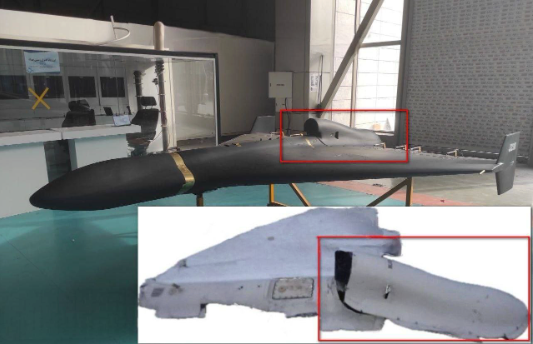
The obvious visible change to the Shahed-136 is the UAV's matte black exterior, which is likely a coating containing carbon fibre in order to make it stealthier while reducing visibility to the eye as well as absorbing radar reflections. Another important difference is the absence of the rear pusher propeller, which has been replaced by a jet engine air intake. There appear to be three variants of the Shahed-238, all of which are powered by the Toloue-10 896 micro-turbojet engine, but have different guidance systems. The conventional model would include the standard GPS/GLONASS-based and inertial guidance systems used in the Shahed-136. The second version will include an infrared system to search for “hot” targets such as military vehicles. The third version will have a radar detection system designed to attack air defence systems and other radars. [49]
The Shahed-238 micro-turbojet engine is mounted inside the fuselage of the UAV, whereas most of the Shahed-136 piston engine is located outside. This reduces fuel storage space, which, combined with the likely increase in fuel consumption, results in a significant reduction in flight range compared to the Shahed-136. It is also likely that the reduction in its internal dimensions may result in a smaller warhead. The Iranians suggest that the maximum speed of the Shahed-238 is about 500 km/h. This extra speed, combined with the lower visibility and possibly less engine noise, would theoretically make the Shahed-238 less vulnerable to ground fire from the Gepard or other heavy machine guns. On the other hand, the higher speed and likely higher heat signature will make the Shahed-238 easier to detect with heat-seeking air defence missiles.[49]
Thanks to its radar homing head, the drone can become an analogue of anti-radar missiles, which are guided by the radiation of search radar stations. Therefore, this could be dangerous for Ukrainian air defence systems. A prototype with an optical guidance system manually controlled by the operator was also shown, which imposed range limitations and required the use of repeaters on the target. However, the presented UAV variants, thanks to their homing heads, seem to be capable of autonomously aim at the target. [50]
Shahed-238 appears to have a nose-mounted camera. This is a novelty, as previous Shaheds relied on satellite guidance to reach the pre-programmed coordinates. The camera can be used in two ways. It may be there to enable visual navigation. Alternatively, the camera may enable terminal guidance controlled by a machine vision system, to identify and lock on to a target. [51]
Because the Shahed 238 is slower and has a smaller warhead than cruise missiles, it could be called a "poor man's cruise missile." Surprisingly, the poor cannot afford it, as it costs the same as a Kalibr cruise missile for Russians. [33] [38] [39]
4.3 Specifications [2] [52] [53] [54]
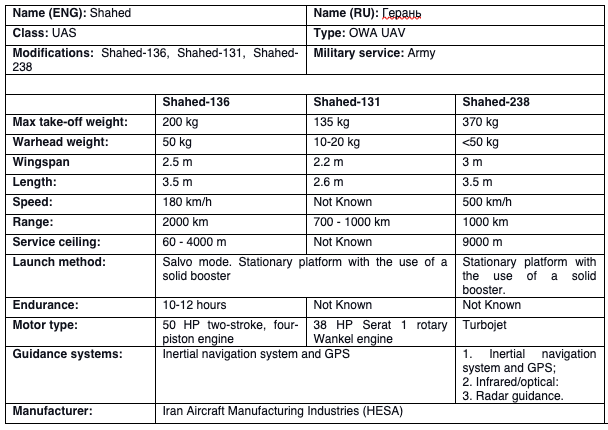
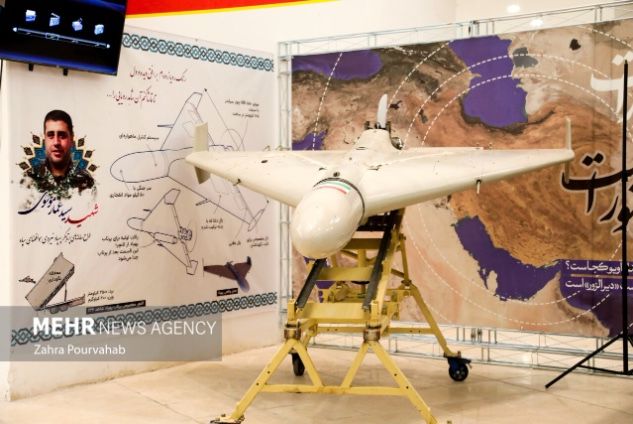

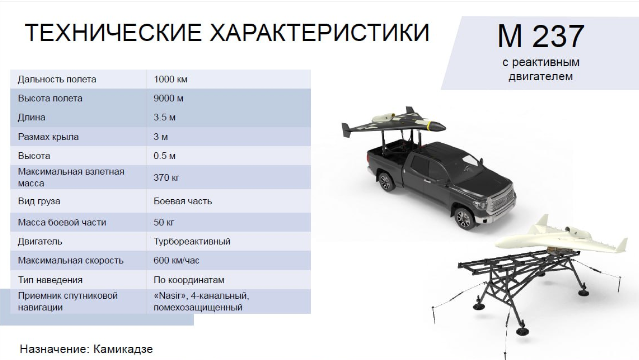
5. Shahed's in Russian invasion of Ukraine
Iranian-made Shahed-131 and Shahed-136 OWA UAVs began appearing in Ukraine in mid-August 2022. Initially, the Russian military appears to have used them primarily as combat UAVs, using them to strike Ukrainian artillery and other medium-value tactical targets. But since mid-October 2022, the Shaheds have become a key component of a coordinated campaign of strategic strikes against key nodes of Ukrainian electricity distribution network and power generation facilities. [55] [56] As the most important port on the Black Sea, the city of Odessa has also been an important target. In July and August 2023, attacks on grain warehouses and storage facilities became more frequent as Russia withdrew from the Black Sea Grain Initiative. [57] The Russians also attacked the Danube port infrastructure with waves of Shahed attacks in August and September 2023. Ukraine's Danube ports have become a key artery for the country's huge grain exports, as Russia has blockaded the Black Sea since the invasion began. [58]
Multiple critics have labelled the Shaheds tactically useless and said their role is to weaponize terror against civilians. Russia’s unleashing of successive waves of Shahed OWA UAVs over Ukraine has several objectives — to disable power plants and other key infrastructure, to undermine morale, and ultimately to drain the Ukrainian's military budget and weapons as they attempt to destroy them. [59] To provoke terror Russian forces deliberately launched Shahed-136 UAVs over Uman to attack Hasidic Jews celebrating Rosh Hashanah (New Year's Eve) in the city. [60] The continuous buzzing of the propeller-driven Shahed UAVs, dubbed “mopeds” and “lawnmowers”, can be terrifying to anyone under their flight path, as no one on the ground knows exactly when or where these weapons will strike. [59]
Terrorizing Ukrainian citizens is certainly one of the main goals of Shahed attacks. For example, on 4 April 2024, Russian forces launched a massive Shahed attack on Kharkiv city, and 15 UAVs struck residential and civilian infrastructure. Moreover, the second wave of Shaheds killed Ukrainian rescuers who were responding to the aftermath of previous strikes, indicating that Russian forces deliberately launched a subsequent wave of Shaheds to exaggerate the terror caused by the initial attack. [61]
From February 24, 2022 to February 22, 2024 the Russian Federation launched 4,637 Shaheds at Ukrainian targets. According to Yuriy Ignat, a representative of the Ukrainian Air Force, the Ukrainian Defense Forces have destroyed 3,605 of them. [62] Ukrainian Air Force Spokesman Major Ilya Yevlash said that Russian forces continue to concentrate strikes on Ukrainian infrastructure and change tactics to find gaps in the Ukrainian air defence system. [63] For example, Russian forces are trying to change Shahed's routes by moving them 5-10 km to the left or right to bypass Ukrainian air defences. [64] UAVs also fly along the course of rivers to get as low as possible and disappear from radar. [65]

The Shahed’s small size and radar cross-section (the average is estimated to be at 0.01 square meters), a very weak heat signature, and the ability to fly very low make it difficult to detect and engage them from longer distances. In addition, short- and medium-range anti-aircraft missiles launched from Osa, Buk and S-300 ground launchers and MiG-29 jet fighters cost hundreds of thousands of dollars. Thus, while the Western NASAMS and IRIS-T systems entering Ukrainian service may be efficient Shahed-136 killers … they are not cost effective killers using half-million-dollars missiles. [15]
On the other hand, the Shahed-136 has a top speed of 180 km/h, almost identical to the World War I-era Sopwith Camel biplane. This means that it takes time to reach its targets and it is vulnerable to short-range anti-aircraft weapons. The 50-horsepower Chinese-made piston engines can be heard many kilometres away, so the Shaheds are unlikely to surprise their targets. Slow UAVs are vulnerable to all kinds of anti-aircraft weapons: rapid-firing 23-millimeter anti-aircraft guns, heavy machine guns (calibres .50, 12.7mm and 14.5mm), and occasionally small arms and man-portable anti-aircraft missiles such as Stinger, Igla or Starstreak. Defence analyst Gustav Gressel claimed that a platoon of German-built Gepard anti-aircraft vehicles made “… a very quick end to 9 Shahed-136s in a few minutes” using radar-guided 35-mm twin cannons. [15] Ukrainian SA-8 missile launchers and Shilka self-propelled anti-aircraft guns are very effective against the relatively crude Shaheds as well. [63] Another interesting hardware hybrid spotted by bloggers in photographs of the exercise near Dnipro was a 12.7-millimeter DShKM heavy machine gun, manufactured under license in Romania and equipped with an Adder TS35-640 thermal imaging sight from AGM Global Vision of Arizona. It can be attached to the weapon on a on a three centimetre diameter tube. Effective against lightly armoured vehicles, aircraft and personnel, the DShK was used extensively by Soviet forces in World War II, and continues to be used in combat to this day in places ranging from Vietnam to the Northern Island and Afghanistan. [67]
In April 2023, information appeared that in addition to jamming the GPS signal, the Ukrainians had begun spoofing it so that Russian UAVs would get lost. Jamming clutters navigation systems (GPS and others such as Russia's GLONASS) with noise. Spoofing causes them to give out an incorrect location, generating a fake signal. [69] In February 2024, it was revealed, that Ukraine had received a new more powerful shield against UAVs that did not rely on ammunitions: a nationwide electronic warfare (EW) system called Pokrova that confuses the navigation systems of UAVs. [70] Also, the Ukrainian Air Force has repeatedly stated that the Shahed attack had been repelled by EW. [71] [72] [73] [74]
There are also increasing reports that only mobile air defence teams equipped with large-calibre automatic weapons and MANPADs were involved in repelling the Shahed attack. [75] [76] Lieutenant-General Serhiy Nayev, Ukrainian Joint Forces Commander, also highly praised the actions of Ukrainian mobile fire groups in intercepting Russian UAVs. [77] This suggests that destroying Shahed may not be as costly for Ukrainian air defence as many experts initially thought. Another notable Ukrainian innovation is the installation of 8,000 mobile phones across the country on six-foot poles, along with microphones that help determine the speed and direction of flying UAVs, allowing mobile air defence teams to respond even faster to Shahed attacks. [78]
6. Conclusion
Beginning in October 2022, just months after the Shaheds appeared in Ukraine, Russia began using them as a key component of a coordinated campaign of strategic strikes against key nodes of Ukrainian electricity distribution network and power generation facilities. Their other roles include to terrorize civilians, wear down air defences and deplete Ukraine's defence spending.
The cost information that Prana Network obtained revealed that Shaheds are not as cheap as previously thought. Moreover, if we take into account the Shahed's lower destructive power and the possibility of being destroyed by cheap German Gepard ammunition or even a machine gun, this significantly reduces the financial benefit of Shahed's compared to traditional cruise and ballistic missiles. As you can see, the more advanced Shahed-238 already costs the same as Kalibr missile, and Russia may be forced to use the Shahed UAVs at any cost simply because it does not have enough other means to attack Ukrainian targets deep in the rear.
In addition to importing Shahed UAVs from Iran, Russia has made significant efforts to develop their production and established a factory in Alabuga. At the same time, Ukraine's armed forces gained new capabilities and demonstrated their ability to attack targets more than 1,000 kilometres away from Ukraine, deep behind Russia’s lines. In any case, the April 2 attack likely didn’t cause devastating irreparable damage to the factory building and did not seriously undermine the morale of its workers. But SensusQ estimates that the April 2 strike will not remain Ukraine's only attempt to destroy the Shaheds UAV factory in Alabuga and we will see more Ukrainian attacks on the Shahed-136 factory in Alabuga in the short to medium term.
Ukraine has increased the role of low-cost mobile air defence teams and deployed the Pokrova EW system in countering the Shaheds. These measures will help both to reduce the threat from Shahed attacks and to reduce the cost of repelling them. Thanks to Western assistance and reduced spending, the Shahed attacks are unlikely to dramatically deplete Ukraine's defence spending. At the same time, the unexpectedly high purchase price of the Shaheds could have an impact on Russia's defence spending. Anyhow, SensusQ estimates that despite the high cost and limited effects of Shahed UAVs, Russia will likely continue to use them to terrorize the population of Ukraine, destroy infrastructure, and wear down air defences for as long as possible. However, such actions will not have a significant impact on the situation on the battlefield, and therefore Russia's intensive use of the Shahed OWA UAVs will not change the course of the war in Ukraine.
[1] United Nations Security Council: Letter dated 18 May 2023 from the Permanent Representative of the United Kingdom of Great Britain and Northern Ireland to the United Nations addressed to the Secretary-General and the President of the Security Council. May 2023. [Online]
[2] The Royal United Services Institute (RUSI): Russia’s Iranian-Made UAVs: A Technical Profile. Jan 2023 [Online]rusi.org/explore-our-research/publications/commentary/russias-iranian-made-uavs-technical-profile
[3] Newsweek: Exclusive: Iran Positions 'Suicide Drones' in Yemen As Red Sea Tensions Rise. Jan 2021. [Online] newsweek.com/iran-suicide-drones-yemen-red-sea-tensions-1561395
[4] AP: White House: Iran set to deliver armed drones to Russia. Jul 2022. [Online] apnews.com/article/russia-ukraine-biden-iran-jake-sullivan-4a9f1b2749893d8f1ed9f039869cf119
[5] United States Institute of Peace: Russia Deploys Iranian Drones. Oct 2022. [Online] iranprimer.usip.org/index.php/blog/2022/oct/12/explainer-russia-deploys-iranian-drones
[6]Twitter, Максим: Spotted Iran striker UAVs in Kupyansk region. Presumably used by Russian forces. Sep 2022. [Online]twitter.com/kms_d4k/status/1569553651273719810
[7] AP: Ukraine’s military claims downing Iran drone used by Russia. Sep 2022. [Online]apnews.com/article/russia-ukraine-kyiv-army-182ef49a89cc5ccbf442d38423b6117f
[8] Reuters: Kremlin denies using Iranian drones in attack on Ukraine. Oct 2022. [Online] reuters.com/world/kremlin-denies-using-iranian-drones-attack-ukraine-2022-10-18
[9] Telegram, RusNews: «Ж*па есть, а слова нет... Мы все знаем, что они иранские, но власти не признают». Oct 2022. [Online] t.me/smirusnews/18906
[10] Telegram, Подъём: «После ковида плохо с мозгом». Эксперт Минобороны, рассказавший про иранские дроны в эфире ТВ, заявил, что не помнит этого. Oct 2022. [Online] t.me/pdmnews/53501
[11] Islamic Republic of Iran, Ministry of Foreign Affairs: Iranian foreign ministry spokesman reacts to some claims about shipment of arms including military drones by Iran to Ukraine. Oct 2022. [Online]en.mfa.ir/portal/newsview/696898
[12] IRGC Chief: Iran Selling Arms to World Powers. Oct 2022. [Online]kayhan.ir/en/news/106464/irgc-chief-iran-selling-arms-to-world-powers
[13] CNN: Iran acknowledges providing drones to Russia before Moscow’s invasion of Ukraine. Nov 2022. [Online] edition.cnn.com/2022/11/05/middleeast/iran-drones-russia-intl/index.html
[14] U.S. DepartmentofDefense transcript: Senior Military Official Holds a Background Briefing on Ukraine. Oct 2022 [Online] defense.gov/News/Transcripts/Transcript/Article/3190979/senior-military-official-holds-a-background-briefing-on-ukraine/
[15] Iran’s Shahed-136 Kamikaze Drone: Everything You Need To Know. Oct 2022. [Online] 19fortyfive.com/2022/10/irans-shahed-136-kamikaze-drone-everything-you-need-to-know
[16] Iran Watch: Iran Aircraft Manufacturing Industries (HESA). Feb 2024. [Online] iranwatch.org/iranian-entities/iran-aircraft-manufacturing-industries-hesa
[17] Suspilne Media: Експертизи встановили, що виробником “Shahed-ів” є іранська авіабудівна компанія – ОГПУ на запит Суспільного. Dec 2023. [Online] suspilne.media/635828-ekspertizi-vstanovili-so-virobnikom-shahed-iv-e-iranska-aviakompania-ofis-genprokurora-na-zapit-suspilnogo/?utm_source=copylink&utm_medium=ps
[18] U.S. Department of The Treasury: Treasury Targets Actors Involved in Production and Transfer of Iranian Unmanned Aerial Vehicles to Russia for Use in Ukraine. Nov 2022. [Online] home.treasury.gov/news/press-releases/jy1104
[19] CNN: US says drone factory Russia is building with Iran’s help could be operational early next year. Jun 2023. [Online] edition.cnn.com/2023/06/09/politics/us-russia-iran-drone-factory/index.html
[20] Протокол: Алабуга. Иранские дроны по франшизе. Jul 2023. [Online] protokol.band/2023/07/03/alabuga-iranskie-drony/
[21] fDi Intelligence: SEZ «Alabuga»: largest in Russia and best in Europe. Oct 2018. [Online] fdiintelligence.com/content/feature/sez-alabuga-largest-in-russia-and-best-in-europe-73061
[22] Twitter: Anton Gerashchenko. FEB 2024. [Online] twitter.com/Gerashchenko_en/status/1754901906323808469
[23] Meduza: Деревня для производства дронов. Как особая экономическая зона в Татарстане превратилась в место сборки иранских беспилотников для войны с Украиной. Jul 2023. [Online] meduza.io/feature/2023/07/03/derevnya-dlya-proizvodstva-dronov-kak-osobaya-ekonomicheskaya-zona-v-tatarstane-prevratilas-v-mesto-sborki-iranskih-bespilotnikov-dlya-voyny-s-ukrainoy
[24] Вот Так: Дроны, которыми наносят удары по городам Украины, собирают в Татарстане — по документам они проходят как «лодки». Главное из расследования издания «Протокол» Jul 2023. [Online] vot-tak.tv/novosti/03-07-2023-drony-rassledovanie
[25] Telegram: ВЧК-ОГПУ: «Протокол» специально для ВЧК-ОГПУ. Jul 2023. [Online] t.me/vchkogpu/40364
[26] The Washington Post: Inside the Russian effort to build 6,000 attack drones with Iran’s help. Aug 2023. [Online] www.washingtonpost.com/investigations/2023/08/17/russia-iran-drone-shahed-alabuga
[27] Institute for Science and International Security: Highlights of Institute Assessment of Alabuga Drone Documents, Supplied by Dalton Bennett at the Washington Post. Aug 2023. [Online] isis-online.org/uploads/isis-reports/documents/Highlights_of_Institute_Assessment_of_Alabuga_Drone_Documents_Final_August_17.pdf
[28] Протокол: Алабуга. Производство смерти руками студентов. Jul 2023. [Online] protokol.band/2023/07/24/alabuga-rukami-studentov/
[29] Meduza: Студентов колледжа в Татарстане отправили собирать иранские дроны-камикадзе для российской армии «Здесь происходит полная жесть». Jul 2023. [Online] meduza.io/feature/2023/07/24/studentov-kolledzha-v-tatarstane-otpravili-sobirat-iranskie-drony-kamikadze-dlya-rossiyskoy-armii
[30] ГУР атакувало завод зі збірки "Шахедів" у Татарстані за 1000 км від України, - джерело. Apr 2024. [Online] rbc.ua/rus/news/gur-atakuvalo-zavod-zi-zbirki-shahediv-tatarstani-1712037601.html
[31] Telegram: Республика Татарстан: Рустам Минниханов оперативно получает информацию по ситуации в Закамье. Apr 2024. [Online] t.me/nashtatarstan_official/10934
[32] All 13 Casualties From Tatarstan Drone Attack Were Students Employed at Kamikaze Drone Factory. Apr 2024. [Online] kyivpost.com/post/30492
[33] The Times of Israel: The Iranian-made killer drones vying for supremacy in Ukrainian skies. Oct 2022. [Online] timesofisrael.com/the-iranian-made-killer-drones-vying-for-supremacy-in-ukrainian-skies
[34] Forbes: Иранские дроны-камикадзе могут быть опаснее, чем дорогие ракеты. Они дешевые и летят далеко. Как они влияют на ход войны. Oct 2022. [Online] forbes.ua/ru/war-in-ukraine/iranski-droni-kamikadze-mozhut-buti-nebezpechnishimi-za-dorogi-raketi-voni-deshevi-ta-letyat-daleko-chi-mozhut-voni-zminiti-khid-viyni-06102022-8833
[35] Molfar: Iranian drones in the Russian invasion: analysis by Molfar experts. Oct 2022. [Online] molfar.com/en/blog/shahed ; docs.google.com/document/d/1tdjS-wiDf4MshJ_pY8pEPgnyGqNO3Q3SQnrRyXUB2pk/edit
[36] The New York Times: Ukraine Keeps Downing Russian Drones, but Price Tag Is High. Jan 2023. [Online] nytimes.com/2023/01/03/world/europe/ukraine-russia-drones.html
[37] Defense Express: How Gepard SPAAG Takes Down Shahed Drones and Why It's So Effective in Doing So, Ukrainian Operators Explain. Sep 2023. [Online] en.defence-ua.com/news/how_gepard_spaag_takes_down_shahed_drones_and_why_its_so_effective_in_doing_so_ukrainian_operators_explain-8093.html
[38] Forbes: $375,000 - The Sticker Price ForAn Iranian Shahed Drone. Feb 2024. [Online] forbes.com/sites/erictegler/2024/02/07/375000the-sticker-price-for-an-iranian-shahed-drone/amp
[39] Telegram: Военный Осведомитель: Также крайне интересны данные по ориентировочной стоимости иранских дронов. Feb 2024. [Online] t.me/milinfolive/115811
[40] Telegram: Военный Осведомитель: Касательно "завышенных" цен на иранские беспилотники из слитых документов. Feb 2024. [Online] t.me/milinfolive/115816
[41] Bank of Finland Institute for Emerging Economies. Latest developments in Russian imports of sanctioned technology products. Nov 2023. [Online] publications.bof.fi/bitstream/handle/10024/53179/bpb1523.pdf
[42]Defense Express: Нетільки Shahed-136, з'явилосьдетальнедослідженнящеодногоіранськогодронакамікадзе, якийвикористовуєРФ.Sep2022. [Online]defence-ua.com/weapon_and_tech/ne_tilki_shahed_136_zjavilos_detalne_doslidzhennja_sche_odnogo_iranskogo_drona_kamikadze_jakij_vikoristovuje_rf-9033.html
[43] Army Technology: Shahed-136 Kamikaze UAV, Iran. Apr 2023. [Online] army-technology.com/projects/shahed-136-kamikaze-uav-iran/
[44] IRN-05 (Шахед-131) БЛА Технічний звіт. [Online] drive.google.com/file/d/1_HdoBYg9n8Df1Mb_gXfec6pFhJXLH70Y/view
[45] Defense Express: Чим "новий" дрон-камікадзе Shahed відрізняється від "старої" версії: п’ять головних відмінностей. Apr 2023. [Online] defence-ua.com/weapon_and_tech/chim_novij_dron_kamikadze_shahed_vidriznjajetsja_vid_staroji_versiji_pjat_golovnih_vidminnostej-12261.html
[46] The Warzone: Russia’s Shahed-136 Drones Now Feature Tungsten Shrapnel. Sep 2023. [Online] twz.com/russias-shahed-136-drones-now-feature-tungsten-shrapnel
[47] АрміяInform: росіяни змінили колір і матеріал «шахедів», щоб ускладнити їх виявлення — Юрій Ігнат. Nov 2023. [Online] armyinform.com.ua/2023/11/25/rosiyany-zminyly-kolir-i-material-shahediv-shhob-uskladnyty-yih-vyyavlennya-yurij-ignat
[48] Telegram: Про зв'язок від Сергія Флеш: На території України був збитий перший Шахед-238 з реактивним двигуном. Jan. 2024. [Online] t.me/serhii_flash/1940M
[49] Kyiv Post: Russian General Claims Jet-Powered Kamikaze Drones on the Way. Dec 2023. [Online] kyivpost.com/post/25335
[50] Militarnyi: Iran Officially Unveils Shahed-238. Dec 2023. [Online] mil.in.ua/en/news/iran-officially-unveils-shahed-238/
[51] Forbes: Iran Unveils Jet-Powered Version Of Shahed Kamikaze Drone. Sep 2023. [Online] forbes.com/sites/davidhambling/2023/09/27/iran-unveils-jet-powered-version-of-shahed-kamikaze-drone/?sh=4d6db98d5bdc
[52] Militarnyi: Russians began to use Shahed-131 kamikaze drones. Oct 2022. [Online]mil.in.ua/en/news/russians-began-to-use-shahed-131-kamikaze-drones/
[53] Janes: IRGC confirms specs for Shahed-136 attack UAV. May 2023. [Online] janes.com/defence-news/news-detail/irgc-confirms-specs-for-shahed-136-attack-uav
[54] Telegram: Военный Осведомитель: В сеть утекли внутренние иранские и российские документы. Feb 2024. [Online] t.me/milinfolive/115795
[55] The Washington Institute: What Iran’s Drones in Ukraine Mean for the Future of War. May 2022. [Online] washingtoninstitute.org/policy-analysis/what-irans-drones-ukraine-mean-future-war
[56] The Washington Post: Drones hit Kyiv as Russia aims to destroy Ukraine power grid before winter. Oct 2022. [Online] washingtonpost.com/world/2022/10/17/kyiv-kamikaze-drone-strike-russia-ukraine
[57] Airwars: A Year of the Shahed. How Iranian drones became a key tool in Russia's arsenal. Sep 2023. [Online] airwars.org/investigation/shahed-year-russia-ukraine-iran
[58] Reuters: Ukraine's Danube port infrastructure hit by Russian drones, driver killed - governor. Dec 2023. [Online] reuters.com/world/europe/ukraines-danube-port-infrastructure-hit-by-russian-drones-driver-killed-governor-2023-12-07
[59] AP: EXPLAINER: Killer drones vie for supremacy over Ukraine. Oct 2022. [Online] apnews.com/article/russia-ukraine-kyiv-business-government-and-politics-5a3e86a903ea5de028308f22f32a00c4
[60] Babel: Some of the Iranian drones that Russia launched in the south of Ukraine were supposed to attack Hasidim in Uman. Sep 2022. [Online] babel.ua/en/news/84817-some-of-the-iranian-drones-that-russia-launched-in-the-south-of-ukraine-were-supposed-to-attack-hasidim-in-uman
[61] "Було близько 20 "Шахедів". У Харкові усувають наслідки нічної атаки безпілотників: що про неї відомо. Apr 2024. [Online] suspilne.media/720700-bulo-blizko-20-sahediv-u-harkovi-usuvaut-naslidki-nicnoi-ataki-bezpilotnikiv-so-pro-nei-vidomo
[62] Fokus: Уничтожена половина "Калибров": РФ выпустила по Украине более 8 тысяч ракет, — Игнат (видео). Feb 2024. [Online] focus.ua/voennye-novosti/628667-unichtozhena-polovina-kalibrov-rf-vypustila-po-ukraine-bolee-8-tysyach-raket-ignat-video
[63] Suspilne Media: Повітряні сили — про російські обстріли: "Ворог постійно змінює тактику, намагається знайти шпарини у системі ППО". Mar 2024. [Online] suspilne.media/714214-povitrani-sili-pro-rosijski-obstrili-vorog-postijno-zminue-taktiku-namagaetsa-znajti-sparini-u-sistemi-ppo
[64] Suspilne Media: Росіяни почали запускати ударні безпілотники “Шахед” з нового майданчика у Криму: що відомо. Dec 2023. [Online] suspilne.media/640912-rosiani-pocali-zapuskati-udarni-bezpilotniki-sahed-z-novogo-majdancika-u-krimu-so-vidomo
[65] Reuters: Ukraine's 'cat and mouse' battle to keep Russian missiles at bay. Dec 2022. [Online] reuters.com/world/europe/ukraines-cat-mouse-battle-keep-russian-missiles-bay-2022-12-22
[66] DefenseNews: Ukraine to target Russia’s bases of Iran-supplied explosive drones. Oct 2022. [Online] defensenews.com/unmanned/2022/10/06/ukraine-to-target-russias-bases-of-iran-supplied-explosive-drones
[67] Forbes: To Stop Killer Drones, Ukraine Upgrades Ancient Flak Guns With Consumer Cameras And Tablets. Dec 2022. [Online] forbes.com/sites/sebastienroblin/2022/12/11/to-stop-killer-drones-ukraine-upgrades-ancient-flak-guns-with-consumer-cameras-and-tablets/amp
[68] The Eurasian Times: Ukraine Uses Powerful Searchlights & Anti-Aircraft Guns To Neutralize Russian Geran-2 UAVs Used During Night Strikes. Jan 2023. [Online] eurasiantimes.com/ukraine-uses-powerful-searchlights-anti-aircraft-guns-to-neutralize
[69] Forbes: Ukraine Is Spoofing Russian Drones Out OfThe Sky. Apr 2023. [Online] forbes.com/sites/davidhambling/2023/04/21/ukraine-is-spoofing-russian-drones-out-of-the-sky
[70] Forbes: Ukraine’s Pokrova Spoofing System Tells ShahedsTo Get Lost. Feb [Online]forbes.com/sites/davidhambling/2024/02/12/ukraines-pokrova-spoofing-system-tells-shaheds-to-get-lost/?sh=28715a5ffea7
[71] Facebook: Командування Повітряних Сил ЗСУ / Air Force Command of UA Armed Forces, 29 March 2024. [Online]fb.com/kpszsu/posts/pfbid023hidbwvxbN814zuq2YN9XTejfD3biFYkGpWbZEqkQoorQVDzPZHaieWiFTomvCcul
[72] Facebook: Командування Повітряних Сил ЗСУ / Air Force Command of UA Armed Forces, 28 March 2024. [Online] fb.com/kpszsu/posts/pfbid0wyB1Xb87sF9FraAFJtppembvHkt4ZytUEpFVri1W1xnf6B865EQoRMmkQW7vmaa8l
[73] Facebook: Командування Повітряних Сил ЗСУ / Air Force Command of UA Armed Forces, 24 March 2024. [Online] fb.com/kpszsu/posts/pfbid02E9itApFzseeXaKMzes3zT2DHaukR6CYLnsEDuAFwXYM1iZ1p4NLLA8C8ztXUPd3Yl
[74] Facebook: Командування Повітряних Сил ЗСУ / Air Force Command of UA Armed Forces, 18 March 2024. [Online] fb.com/kpszsu/posts/pfbid0J2aqMT3K6v9zqzLrzTJSNGyKek2zN9YPDRvLktMsgtVS3vWoQh4F6AM73ruYujyQl
[75] Facebook: Командування Повітряних Сил ЗСУ / Air Force Command of UA Armed Forces, 30 March 2024. [Online] fb.com/kpszsu/posts/pfbid02hbTpbfrewWVhSJnmYrtss8BLn3xZzQFy2Twx1NbBC3HqmzsGaUzv7REMAUwKKtv5l
[76] Facebook: Командування Повітряних Сил ЗСУ / Air Force Command of UA Armed Forces, 26 March 2024. [Online] fb.com/kpszsu/posts/pfbid0k6Guvgya2qdhfb6oQbHrJ4nrk3pojTZSVQ36JC58LFfwNSQw1t1UP6sdYrCCfhZyl
[77] АрміяInform:Напівночімобільнігрупизнищилибільшістьворожихбезпілотників — СергійНаєвпронічнуатаку «Шахедів». Nov 2023. [Online] armyinform.com.ua/2023/11/25/na-pivnochi-bilsha-polovyna-vorozhyh-bezpilotnykiv-znyshhena-mobilnymy-grupamy-sergij-nayev-pro-nichnu-ataku-shahediv
[78] Wall Street Journal on YouTube: Lessons on Low-Cost Deterrence and DronesFrom Ukraine. Mar 2024. [Online] youtube.com/watch?v=1O0sRM-uY7E